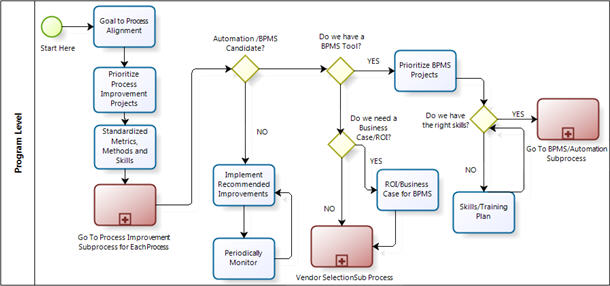
Where and how you get started with BPM can range in scope from a single process to an initiative that spans an entire organization. It can vary from a small project that simply documents and inventories all processes to a full blown enterprise wide deployment of BPMS technology.
The next section looks at the many possible dimensions of BPM initiatives and offer some insights and suggestions. We'll look at a high level at the approach you might take, the methods you may use and the skills you will need to implement a BPM initiative. As discussed in the primer – the scope and goals should determine the method. All three (scope, goals and method), should then guide and drive everything else.
Scope defines the target of the initiative – the entire company, a business area (like HR) or a single process. The Goal of the initiative may be to simply understand and communicate the existing process, improve it, automate it or entirely reengineer it. If we place these major factors on a two dimensional graph we can do a bit of level setting in various areas.

Fig 1.
Fig 1 is the Cost/Effort and Benefits curve that we would expect will play out. It simply shows that large, wider scale, more complex efforts while more expensive to implement, should have some commensurate benefit (if there is any justice in the world and that basic economies of scale apply). It also tries to show that your approach, methods and skill requirements will vary highly with your 'entry-point' into, as well as the complexity of, your environment and your high level goals:
 Are you simply trying to do some analysis to understand your processes to see if you can eke out any efficiencies?
Are you simply trying to do some analysis to understand your processes to see if you can eke out any efficiencies?  Are you trying to apply BPM to solve a specific well understood process problem or are you looking to institute it enterprise-wide across many processes?
Are you trying to apply BPM to solve a specific well understood process problem or are you looking to institute it enterprise-wide across many processes?  Are you planning to use BPMS technology and to what degree?
Are you planning to use BPMS technology and to what degree?  Is this initiative being driven from the top down with significant budget or is this a grass roots initiative from the bottom up?
Is this initiative being driven from the top down with significant budget or is this a grass roots initiative from the bottom up? 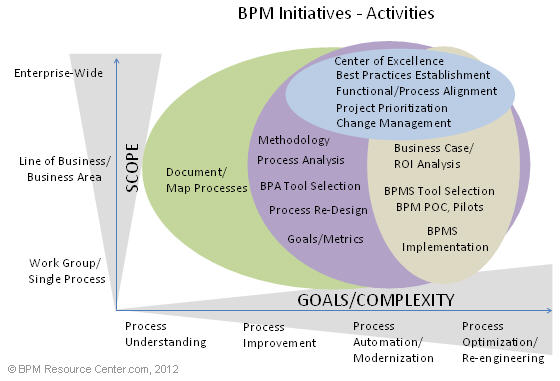
Fig 2.
In Fig 2, we look look at methods and activities you might undertake against the same factors of scope, goals and complexity.
All BPM initiatives start with understanding the process; from there activities will very much depend on the scope, goals and methods being used.
As you move into the process improvement area, you may:
 Perform process analysis and redesign.
Perform process analysis and redesign. Investigate, evaluate and purchase BPA Tools if needed.
Investigate, evaluate and purchase BPA Tools if needed. Establish goals and metrics to measure success.
Establish goals and metrics to measure success.As you move more into automation and optimization you will likely:
 Have to make the business case for a BPMS tool.
Have to make the business case for a BPMS tool. Perform Proof of Concepts (POCS) and/or Pilots.
Perform Proof of Concepts (POCS) and/or Pilots. Fully implement BPMS.
Fully implement BPMS.The broader the scope of your initiatives, the more you will need to consider:
 Aligning functions to process and process to strategic goals and objectives.
Aligning functions to process and process to strategic goals and objectives. Establishing Best Practices.
Establishing Best Practices.  Creating a Center of Excellence so that approaches can be standardized and made consistent and repeatable.
Creating a Center of Excellence so that approaches can be standardized and made consistent and repeatable.  Have a well defined change management system or method.
Have a well defined change management system or method.All BPM initiatives start with understanding the process. To improve process understanding you will need to determine the mapping/documentation approach to take, be it for a single process or hundreds of processes and/or the relationship between processes. If the goal is process improvement taken all the way through analysis and process re-design, then methodology becomes a much larger consideration. In that case you should probably take advantage of methods like Lean, Six Sigma, Lean Six Sigma or some approach that incorporates techniques for process analysis. It will also be much more important to formally establish metrics and goals to measure your improvement success.
If you determine that process improvement will include using process automation technology, then you are likely looking at investing in a BPMS tool. If you don't have this in-house (or if the current in-house tool is inadequate) you'll will need to make the business case for a BPMS tool investment. There are various BPM ROI tools you can use that can help. You should also consider POCs and pilots as a way to prove out the value of BPMS.
BPA Tools (a subset of BPMS) include tools for visual/electronic process mapping and documentation tools. If the initiative will extend enterprise-wide, then seeking tools that include a process library to centrally store processes can be beneficial. More and more BPA systems are incorporating this and other features that allow users to collaborate electronically on processes.which can be beneficial for smaller groups or even essential for large and geographically dispersed organizations.
BPA tools are also designed to help facilitate specific process improvement methodologies and analysis techniques. Based on the methodology you choose, consider tools that offer value stream mapping, simulation capabilities, activity based costing, critical path analysis and other capabilities that match your analysis needs.
If your goal is improvement through automation there is a broad range of BPMS tools in the market to choose from. BPMS tools can help to achieve a paperless office, extend and enhance existing ERP and other core business systems by closing gaps in those systems, facilitating approvals or improving exception management.
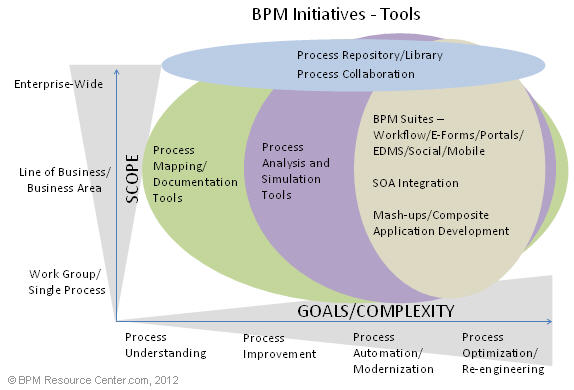
Fig 3.
For more on this, see the section on Selecting BPA/BPMS tools, including ten tips for BPMS vendor selection.
If you plan to apply automation to many processes (in a given business area/department) then tools to aid in project prioritization will be essential. Prioritization tools and techniques can also help with pilot project selection.
As you move towards optimization and/or if you are entirely re-engineering a process, you may want more sophisticated functions and architecture underpinnings for your BPMS such as Service Oriented Architecture (SOA) and mash-up/composite application development tools (if they aren't already established).
Of course, the broader the scope of your initiatives, the more you will need to consider best practices and a center of excellence so approaches can be standardized and repeatable. As BPM impacts the way people do their every day work, you will need to consider how to handle the organizational change.
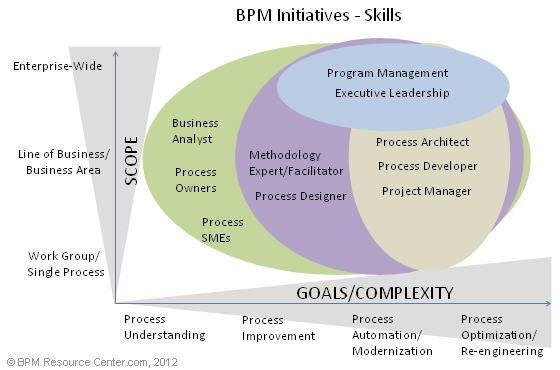
Fig 4.
Roles and Skills will also vary based on initiative scope. The following provides a high level overview of the various roles involved in a BPM initiative.(Keep in mind that a single individual may be handling the responsibilities of multiple roles). You may obtain these skills form outside consultants or by training and certifying your own employees.
The following provides a high level overview of the various roles involved in a BPM initiative.(Keep in mind that a single individual may be handling the responsibilities of multiple roles).
- The Process Owner is ultimately responsible for the effectiveness of the process. The process owner defines the metrics to be used to track the process and monitors the process. They make final decisions as to the steps of the process and are responsible to ensure that it meets business objectives.
- Business/Process Analysts generally gather as-is process data, perform process mapping, perform process analysis and process redesign (to-be process mapping). For process automation projects, Business/Process Analysts also act as a liaison between IT and the Business stakeholders, provide to-be process requirements, prototypes and use cases. They also typically perform application testing and assist with process training.
- Methodology Facilitators may be required if you are planning to adopt a more formal method like Lean Six Sigma to help facilitate workshops and redesign efforts.
- Process Designers/Process Architects are responsible for the technical designs of to-be processes for process automation projects and how they may fit into the enterprise architecture.
- Process Developers support process automation and redesign efforts by developing database schemas, developing any needed system interfaces where integration is required, developing user interfaces and complex forms. Often they are also responsible for process assembly.
- Project Managers will manage one or more automation/reengineering projects handling resource planning, issue tracking and management, schedule management, risk management and task management.
- Program Managers (or Process Program Directors) are generally needed when BPM initiatives span organizations and/or are being implemented enterprise-wide. They help establish corporate wide methods and best practice, drive tool selection, help to prioritize projects and resource investments, perform ROI analysis, roll up individual project status and measure project success based on established and standard metrics and goals.
- Process Owners and SMEs (Subject Matter Experts) provide input on the process, participate in workshops. For automation initiatives, they should also participate in to-be design sessions and application testing.
Below is a view of the high level steps you might take if you are starting from the top (so to speak). This outline might vary depending upon your entry point (Tier 1, 2 or 3 in the funnel we discussed in the earlier) or your initiative scope (single project or enterprise-wide).
Tier 1 – Process Understanding
You can’t manage processes that are not understood, so the first step is to define a standard approach to organizing, documenting and maintaining your processes. You may want to consider evaluating your organization against the Business Process Maturity Model and determine the level of “process maturity” you are aiming to achieve.
1) Obtain or train skilled resources - Based on the size of your organization, you will have to determine who handles this activity (a process analyst or group, outside consultant) and where this individual or group of individuals reside (under the COO) .
2) Establish a framework for standardization - You should adopt a standard framework to follow to ensure categorization, naming convention, modeling standards, etc. APQC offers frameworks for many industries and BPMN is a popular standard for EPC (Event driven Process Chain) activity level modeling. Define standards for versioning and other aspects of your documentation as well. It is also likely you will want to pick a tool to use for modeling.
3) Establish a repository - Define where to store your process models and documentation. On a wiki, a document library like Sharepoint or a repository that is provided with a modeling tool.
Tier 2 – Process Improvement
The following process is a flow that describes activities involved in a programmatic approach to process improvement. The diagrams in this section are taken from the practical BPM Toolkit, learn more…
BPM Initiative Process - Process Improvement
Fig 5.
At the Program Level, you should start with the alignment of goals to processes. While most all processes can benefit from BPM improvement efforts, you should prioritize those process improvement projects that have the greatest business potential. Before moving to the “Process Improvement Sub-process” (first child process in red) you should establish standard metrics so that you can measure process improvement impact over time. You will also need to establish the methods you will use and the skills your teams will need (i.e. individuals to train from your own staff, corporate resources you might need, facilitators or consultants to hire, etc.)
Once the process improvement activity is complete, recommendations for improvements can be made.
BPM Process Improvement Process - Followed For Each Process
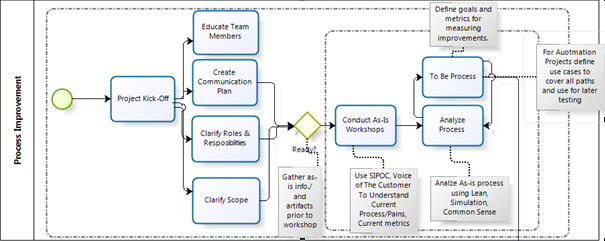
Fig 6.
7 Steps to Implementing a BPM Improvement Project (A single process)
It would be very difficult to find two BPM projects that are the same. Process complexity, corporate culture, internal politics, personalities, organization size and other factors make each project a very different animal that needs different care and feeding.
But well structured and effective projects tend to progress in a similar fashion. The steps below are offered as a general guide. Keep in mind that it will also vary with how formal your approach needs to be, how long each step might take (if indeed the step is required at all).
Step 1: All projects should start with a project kick-off session.
Assuming the project has a business sponsor, a process owner is identified and it has been deemed a project suitable for BPM, the first step is the project kick-off. Kick-off meeting roles should clearly be defined for all participants. A communication plan should be established and reviewed to clarify frequency of meetings, methods and other communications such as where relevant project documents, etc. The kickoff is an opportunity to educate any team members unfamiliar with BPM and the goals of the project. Get everybody on the same page and promote the benefits each will receive. If you go overtime and need to extend your kickoff- do so! Short changing your self here can really hurt your chances for a successful outcome.
Step 2: Data Gathering. The team should then gather artifacts and data that will be used in your workshop. Consider providing a template checklist document for clarification, best practice and consistency. Data will include time, volumes, example documents or forms, screen shots or access to current systems, etc.
Step 3: Workshop 1 As-Is Process Conduct a workshop with the key stakeholders and process participants to understand and document the current process. Sessions should be at least 4 – 8 hours to capture an in-depth understanding of the process. This is where you can use techniques like a SIPOC diagram, collaboration and other process mapping methods. Remember to gather a full set of metrics, not just steps and how long activities take, but important measures such as how many people are involved, volumes processed, calls dropped, errors recorded and so on.
Step 4: Workshop 2 Process Analysis. Once all the as-is process information is understood you will begin the analysis. The first key objective is to make sure you understand the challenges with the existing process (activities) and what the real goal(s) of an improved process are. Look to see what steps can be consolidated, what can be eliminated, what can potential be facilitated by technology/automation. Some analysis for more complex processes may require being done off line by a business or system analyst and presented to the group.
Step 5: Workshop 3 To-Be Process: The team then gets together in a follow-on workshop to produce a new to-be process. This should include not only how the new process will be performed but what metrics will be used to measure the success of this newly defined process. For example: expected volumes to be processed in a period, expected turn-around times, transactions per period. The to-be design may require several iterations, especially if the goal is to apply automation/BPMS technology to the new to–be process.
Step 5 A: BPMS Implementation
Step 6: Perform and Measure the New Process – Aim to continuously improve
Train process participants on the new process and begin to capture metrics. Periodically review the results and revisit the process to see what additional changes could be made for further improvements.
Step 7: Communicate Results
Make sure everyone in the organization is aware of the results and reward and compliment all those involved!
